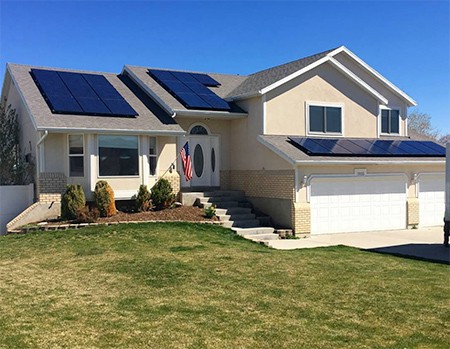Using solar energy panels is a great way to capture energy from the sun and transform it into electrical power that can be used in homes.

Among the concerns with generating solar power tree shade and shade created by clouds and other obstacles reduces the amount of energy the panels collect. With a solar panel small amounts or prolonged shade can cause a solar panel problem when it comes to consistent solar energy collection and adequate electricity generation for homes.
Solar energy experts address the shading effect on solar panels through the use of several technologies including reconfigurable photovoltaic (PV) modules.
Let’s discuss it!
Improved Efficiency Required
Without regularly getting full sunshine solar panels can’t produce energy as effectively. With trees and other obstructions shading the solar panels, the efficiency of power generation will be reduced. When there’s a solar cell shaded, this can be problematic. With a solar panel small amounts of shading can result in energy output being reduced. However, solar panels can work in shade. Solar panel shading leading to lower sunlight exposure can be addressed through the use of a number of innovative technologies.
An Effective Solution
There are several technologies that can be used to minimize the loss of efficiency of shaded panels. They include string inverters, micro-inverters, power optimizers and reconfigurable PV modules. Each of these technologies employs different methods to address the energy reduction the PV system suffers because of solar panel tree shading and being partially or fully shaded by clouds, structural design or other factors for a few hours or all day. When these technologies are used, they make it possible for the PV system to work at near maximum efficiency.
String Inverters
This type of inverter technology is basic and widespread. It helps PV cells to provide the electrical energy people use to run the appliances and systems in their homes. String inverters work in concert with solar panels to create alternating current from the direct current the solar panels produce. Even with some shade string inverters can help to minimize the efficiency losses. With the effectiveness of the inverter string shade covering some of the solar panels becomes less of a problem. The same string inverter is connected to many of the solar panels and works to maximize the electricity they produce.
Micro-Inverters
A photovoltaic system with solar panels arrays that employ micro-inverters has an inverter that’s connected to each individual solar panel. Micro-inverters help to overcome the shading effect on solar panels by working independently to improve the energy efficiency of the overall solar array. When a solar panel array has been equipped with micro-inverters, energy production tends to remain very high. They are able to mitigate the reduction the supply of solar power tree, cloud or any other type of shading can cause. The micro-inverters in the panels around it will help the rest of the array to function at peak efficiency.
Power Optimizers
Power optimizers can also play a very important role in increasing the energy generated by solar panel arrays even where there’s solar panel damage. When power optimizers are connected to each solar panel, they help to ‘condition’ the DC electricity the panels generate and move them along to the string inverter. It’s one of the total shading solutions that can help the system to overcome the impact the reduced energy generated by a single shaded panel has on the entire system. Even with some string shade, power optimizers can increase electricity generation.
Total Shading Solutions
For people committed to installing a solar PV system who realize the system will be subjected to partial shading much of the day, a simple solution would be using a PV system that includes string inverters, micro-inverters, power optimizers or reconfigurable PV modules. Even with partial or full shade string inverters and reconfigurable PV modules can help. Although adding inverters and reconfigurable PV modules will necessitate a larger initial investment, the result will be higher electricity production. Over the long-term that will result in greater saving and will help recoup the higher initial investment several times over even with solar panel damage.
Reconfiguring Solar Cells
When clouds, trees, roof design or other factors regularly cast full or partial shade over PV module solar panels arrays, it can significantly reduce the amount of energy the solar panel arrays can generate. To get around the issue of solar panel shading caused by shading clouds and trees, solar energy experts can install reconfigurable solar modules. The reconfiguration of solar cells has proven to be very effective in improving the energy production delivered by PV modules impacted by full or partial solar panel shading. The only question is the long-term cost/benefit of reconfiguring PV modules.
Installing Reconfigurable PV Modules
There are several types of reconfigurable photovoltaic module architecture that can be used to solve the full or partial shading problem. Their integrated switches dynamically locate faulty PV cells and facilitate PV panel reconfiguration. This produces PV module arrays with near-optimal reconfigurations that maximize the PV system power output under partial shading while bypassing PV cells that are faulty. Simulation results show reconfigurable PV modules which have a snake-like configuration provide higher energy production than conventional modules under full and partial shading scenarios.
Snake PV Modules Reconfiguration
Another method for dealing with block shading is the use of snake PV module reconfiguration. Research models have shown that employing snake PV module reconfiguration can offer energy production that’s higher than conventional modules are able to deliver when dealing with partial, full or block shading. Granted there is an additional investment cost to using reconfigured snake PV modules as part of the solar panel array on a home, but the resultant increase in energy production makes the higher cost worth it because of the benefits it provides to reconfigurable topologies.
Cost-Energy Analysis
Conventional PV modules cost significantly less to use in a solar array than reconfigurable snake PV modules. Not only do the reconfigured snake PV modules cost more, they require special frames and wiring as well as specially trained and licensed installation technicians. However, when you take into consideration the positive long-term impact reconfigured snake PV modules have on the energy production in homes dealing with the shading effect on solar panels, it’s easy to see why using them is a wise investment. Using conventional PV modules reduces costs in the short-term, but results in far less energy production over time.
Reconfigured PV Modules Profitability Over 20 Years
Photovoltaic energy generation has received significant attention and research. Its ability to produce an abundance of solar energy and the ease with which is can be scaled up has led to the development of a wide array of photovoltaic energy generation technologies. Cost/benefit analysis shows increased energy production in a variety of simulated full, partial and block shading scenarios. Over 20 years, its use in a wide range of locations remain economically profitable throughout the entire year, especially during periods when the potential for energy generation is high.
Reconfigurable PV Module Benefits
Installing a PV system can lower energy costs and create a secure source of electricity with almost no negative environmental impact. Photovoltaic modules are simple to operate, durable, reliable, quiet and deliver high quality power. However, with a conventional solar panel small issues like shading clouds, having a cell shaded, string shade, or a solar panel problem can reduce energy output. The solution is to use reconfigurable PV modules. While they cost a little more, reconfigurable PV modules increase electric energy production under shading significantly.
